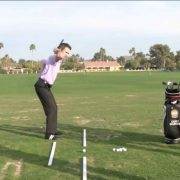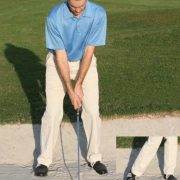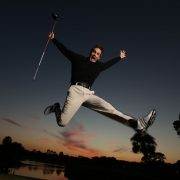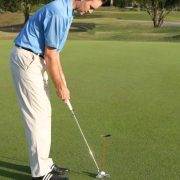Golf Ball Flight Laws

Ball flight law discussion is one of the more technical concepts in our series. Please bear with me just a little bit because understanding these concepts will prove enormously important as you develop your golf game. Only when we know the reasons why a ball travels where it does can we make necessary adjustments. I want you to be able to do this on your own without an instructor looking over your shoulder.
Recognizing that we can really get into a lot of detail here, such as centeredness of contact, gear effects, spin rates, and all sorts of other details, I feel it’s most beneficial for a relative beginner to know the general concepts as they apply to your game. The good news is that if we break it down to its simplest form, there are only two main factors that determine the direction that a golf ball will travel: the path that the club is traveling on at the moment of impact, and the club’s face angle relative to that path.
Consider that any time the club face angle is perpendicular to the path that the club is traveling on, a straight shot will result. That doesn’t necessarily mean it will go at the target, as that depends on the path of the club, but the ball will have no side spin and will travel straight.
If a shot curves to the right, this means that the club face angle was open, or pointing to the right, relative to the path that the club was traveling on at impact. Conversely, when a shot curves to the left, this means that the club face angle was closed, or pointing to the left, relative to the path of the club at impact.
In terms of the direction that a golf shot starts, meaning the first few yards of flight, this is a combination of the path of the club and the direction of the club face. In simplest terms, the ball will start in a direction somewhere between the path of the club and the direction that the club face is pointing. For example, if the path of the club is left of the target line, and the club face is pointed at the target, the ball will start slightly left of the target line.
To add just one more degree of technicality, the direction of club face is normally more dominant in determining a shots direction than swing path. That said, the relative influence that swing path and club face have on the direction of a golf shot varies depending on the loft of the club being used. For instance, with a driver, club face angle accounts for almost entirely the direction and shape that the ball will travel in. On the other end of the spectrum, with a sand wedge, swing path becomes relatively more important.
In summary, it’s important to know the physics behind your golf shots. This will enable us to do what we call reading our shots, and allow us to make appropriate adjustments and improvements in our game over time. There are only two factors to consider in general terms: swing path and club face angle. The starting direction of each shot will be somewhere between the path that the club is traveling on and the direction the club face is pointing. From there, whether the ball curves to the left, to the right, or travels in a straight line, depends on the club’s squareness to the swing path. The relative importance of swing path and face angle vary depending on loft, with face angle of increasing influence in your longer, less lofted clubs.









